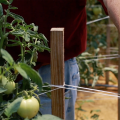News By Department: Plant and Soil Sciences
If you need something green to brighten up your space or get you through the winter months, there is a plant out there for you. But efore you shop for plants, understand the environment of your home or office because different plants have different needs. You must consider six factors when choosing indoor plants if you want to be successful: light, temperature, water, humidity, soil, and fertilization.
Blueberry growers and others interested in growing blueberries commercially can learn more about the crop during an upcoming workshop.
Do you have improving your garden or landscape on your New Year’s resolution list? If you don’t, you should! Each month, we are going to offer a few suggested tasks to do. So, without further ado, here are four tasks for you to complete in your garden and landscape during the month of January:
Video by Michaela Parker
Muscadines are a great fruit to grow at your home, especially here in Mississippi. They thrive in warm, humid weather, making them the perfect fruit to grow in your backyard! If you have been thinking about setting up a muscadine vineyard, here are a few tips to get you started.
Sweet potatoes and yams. They’re the same thing, right?
Not really. They look and taste different. Sweet potatoes (Ipomoea batatas) are sweeter with a smooth, thin skin. (Photo by Kevin Hudson)
Blueberries aren’t just delicious. They’re high in antioxidants, fiber, and vitamins, which is part of the reason they have gained popularity in our kitchens. (Photo by Jonathan Parrish/MSU Extension)
RAYMOND, Miss. -- Despite the weather challenges this year, most Mississippi pecan producers expect a good yield.
However, a wet spring and late-summer drought could mean nut loss and lessened nut quality for some growers.
If you have caladiums in your landscape and want to be sure they come back next year, you’ll need to dig them up just before the first frost. Mississippi’s winters are too cold for the plants to survive in the ground.
If you want to grow muscadines at your home, choosing the right variety can be intimidating. With so many varieties to pick from, how do you know you’re picking the right one?
Fall is one of the best times to divide perennials, such as daylilies and irises. It is best to divide these kinds of plants when they are not blooming. If you don’t get this task done in fall, don’t worry. You can divide perennials throughout the winter and into early spring.
You’ve spent all summer planting and maintaining your garden or mowing your lawn and are ready for a break. But before you put your landscape to bed for a long winter’s nap, consider applying lime.
People can learn about timely topics related to muscadine vines during the 2019 Muscadine Field Day Aug. 29 in Carriere.
If you planted fall tomatoes, soon you’ll need to install a support system to keep the branches and fruit off the ground. There are three different systems for supporting tomatoes: staking, trellising, and caging.
Mississippi forage producers can grow a bountiful crop, but they are fighting wet weather and pests to harvest all of it.
Rocky Lemus, forage and grazing specialist with the Mississippi State University Extension Service and researcher with the Mississippi Agricultural and Forestry Experiment Station, said hay harvest is about 5% behind where it was this time last year.
Pruning is a task I put off, and my blueberry bushes serve as a testament to this fact. Mainly, I am unsure how to do it correctly most of the time and don’t want to kill my plants.
All of Mississippi’s 2019 cotton crop has emerged, but it’s off to a slow start.
Of approximately 700,000 acres of cotton planted statewide this year, 57% is rated fair or worse by the U.S. Department of Agriculture as of July 8.
A new floral design course intended to enhance skills and inspire community volunteerism is now easily accessible to floral enthusiasts statewide.
If edibles are on your list for the landscape or garden this year, check out the list of Mississippi Medallion winners. They are proven performers when it comes to our Mississippi climate.
Our horticulture experts help select several plants, including fruits and vegetables, each year that make the cut.
Corn producers rushed to finish planting -- or replanting -- as much as sunny weather has allowed so far in May.
Floral enthusiasts can learn how to make a basic floral arrangement in the Sweet Mississippi Flower Bowl workshops this summer.


















